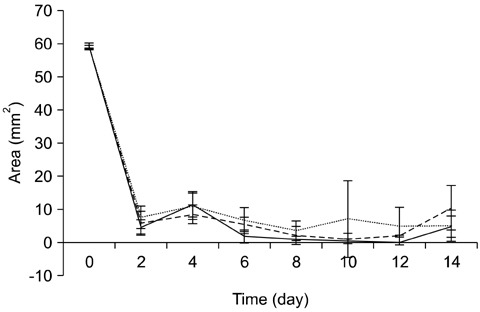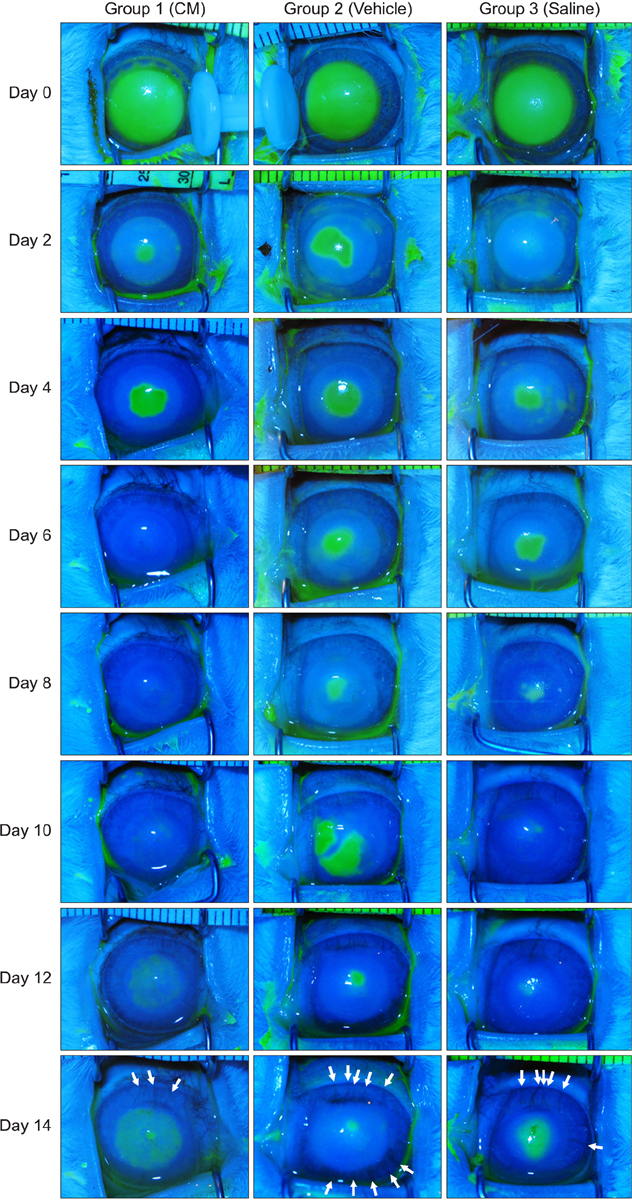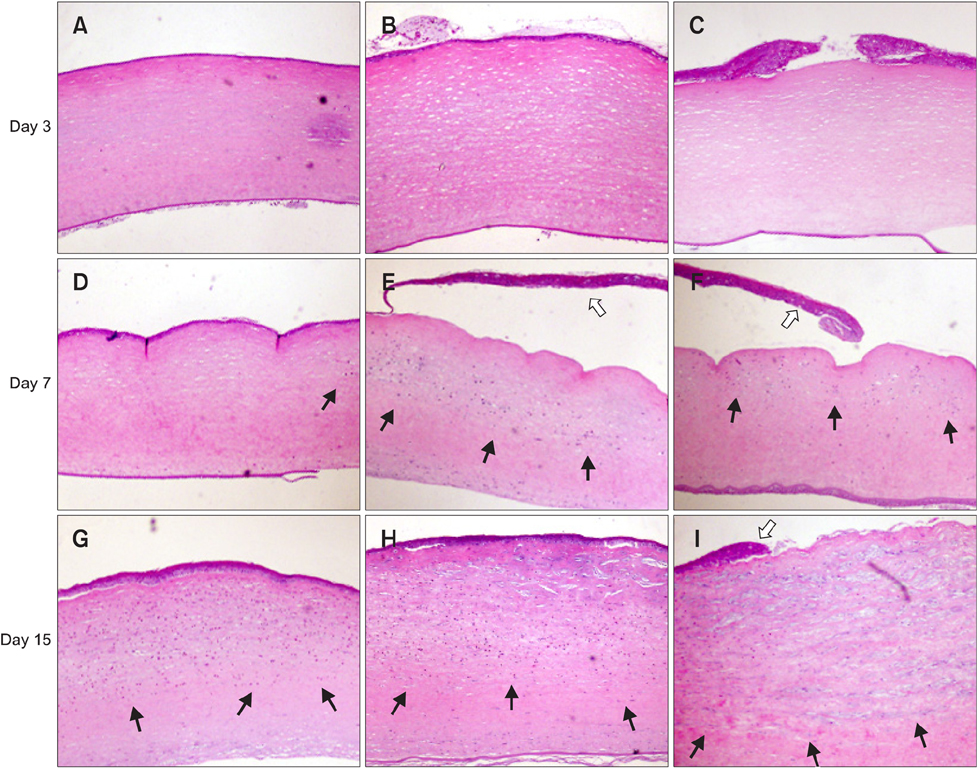J Vet Sci.
2013 Mar;14(1):61-67. 10.4142/jvs.2013.14.1.61.
Effects of conditioned media from human amniotic epithelial cells on corneal alkali injuries in rabbits
- Affiliations
-
- 1Department of Veterinary Surgery and Ophthalmology, College of Veterinary Medicine and BK21 Program for Veterinary Science, Seoul National University, Seoul 151-742, Korea. kmseo@snu.ac.kr
- 2Department of Veterinary Public Health, College of Veterinary Medicine and BK21 Program for Veterinary Science, Seoul National University, Seoul 151-742, Korea.
- KMID: 1482814
- DOI: http://doi.org/10.4142/jvs.2013.14.1.61
Abstract
- This study was performed to evaluate the effects of conditioned media (CM) from human amniotic epithelial cells (HAECs) on the corneal wound healing process. Eighteen rabbits (36 eyes) were used and randomly assigned to three groups according treatment: CM from HAECs (group 1), vehicle alone (group 2), and saline (group 3). Corneal alkali injuries were induced with 1 N sodium hydroxide. Each reagent used for treatment evaluation was injected into the dorsal bulbar subconjunctiva and the area of the corneal epithelial defect was measured every other day. Two animals from each group were euthanized at a time on days 3, 7, and 15, and the cornea was removed for histological examination. The sum of the epithelial defect areas measured on day 0 to day 6 as well as day 0 to day 14 in group 1 was significantly smaller than those of other groups. Histological examination revealed that the group 1 corneas had less inflammatory cell infiltration and showed more intact epithelial features compared to the other groups. These results suggest that CM from HAECs promote corneal wound healing in rabbits.
MeSH Terms
Figure
Reference
-
1. Castro-Combs J, Noguera G, Cano M, Yew M, Gehlbach PL, Palmer J, Behrens A. Corneal wound healing is modulated by topical application of amniotic fluid in an ex vivo organ culture model. Exp Eye Res. 2008. 87:56–63.
Article2. Chang CY, Green CR, McGhee CNJ, Sherwin T. Acute wound healing in the human central corneal epithelium appears to be independent of limbal stem cell influence. Invest Ophthalmol Vis Sci. 2008. 49:5279–5286.
Article3. Chung JH, Fagerholm P, Lindström B. The behaviour of corneal epithelium following a standardized alkali wound. Acta Ophthalmol (Copenh). 1987. 65:529–537.
Article4. Chung JH, Park YK, Paek SM, Chong YH, Kim WK. Effect of Na-hyaluronan on stromal and endothelial healing in experimental corneal alkali wounds. Ophthalmic Res. 1999. 31:432–439.
Article5. Conrad JM, Robinson JR. Mechanisms of anterior segment absorption of pilocarpine following subconjunctival injection in albino rabbits. J Pharm Sci. 1980. 69:875–884.
Article6. Drøhse H, Christensen H, Myrhøj V, Sørensen S. Characterisation of non-maternal serum proteins in amniotic fluid at weeks 16 to 18 of gestation. Clin Chim Acta. 1998. 276:109–120.
Article7. Gabison EE, Huet E, Baudouin C, Menashi S. Direct epithelial-stromal interaction in corneal wound healing: role of EMMPRIN/CD147 in MMPs induction and beyond. Prog Retin Eye Res. 2009. 28:19–33.
Article8. Geerling G, Maclennan S, Hartwig D. Autologous serum eye drops for ocular surface disorders. Br J Ophthalmol. 2004. 88:1467–1474.
Article9. Grueterich M, Espana EM, Tseng SCG. Ex vivo expansion of limbal epithelial stem cells: amniotic membrane serving as a stem cell niche. Surv Ophthalmol. 2003. 48:631–646.
Article10. Hao Y, Ma DH, Hwang DG, Kim WS, Zhang F. Identification of antiangiogenic and antiinflammatory proteins in human amniotic membrane. Cornea. 2000. 19:348–352.
Article11. Herretes S, Suwan-Apichon O, Pirouzmanesh A, Reyes JMG, Broman AT, Cano M, Gehlbach PL, Gurewitsch ED, Duh EJ, Behrens A. Use of topical human amniotic fluid in the treatment of acute ocular alkali injuries in mice. Am J Ophthalmol. 2006. 142:271–278.
Article12. Johnson AM, Umansky I, Alper CA, Everett C, Greenspan G. Amniotic fluid proteins: maternal and fetal contributions. J Pediatr. 1974. 84:588–593.
Article13. Kamiya K, Wang M, Uchida S, Amano S, Oshika T, Sakuragawa N, Hori J. Topical application of culture supernatant from human amniotic epithelial cells suppresses inflammatory reactions in cornea. Exp Eye Res. 2005. 80:671–679.
Article14. Kim JC, Tseng SC. Transplantation of preserved human amniotic membrane for surface reconstruction in severely damaged rabbit corneas. Cornea. 1995. 14:473–484.
Article15. Kim JS, Kim JC, Na BK, Jeong JM, Song CY. Amniotic membrane patching promotes healing and inhibits proteinase activity on wound healing following acute corneal alkali burn. Exp Eye Res. 2000. 70:329–337.
Article16. Koizumi N, Inatomi T, Sotozono C, Fullwood NJ, Quantock AJ, Kinoshita S. Growth factor mRNA and protein in preserved human amniotic membrane. Curr Eye Res. 2000. 20:173–177.
Article17. Kuznetsov SL, Nikolaeva LR, Spivak IA, Chentsova EV, Poltavtseva RA, Marei MV, Sukhikh GT. Effect of transplantation of cultured human neural stem and progenitor cells on regeneration of the cornea after chemical burn. Bull Exp Biol Med. 2006. 141:129–132.
Article18. Matsuda M, Ubels JL, Edelhauser HF. A larger corneal epithelial wound closes at a faster rate. Invest Ophthalmol Vis Sci. 1985. 26:897–900.19. Pfister RR, Burstein N. The alkali burned cornea I. Epithelial and stromal repair. Exp Eye Res. 1976. 23:519–535.
Article20. Rahman I, Said DG, Maharajan VS, Dua HS. Amniotic membrane in ophthalmology: indications and limitations. Eye (Lond). 2009. 23:1954–1961.
Article21. Shahriari HA, Tokhmehchi F, Reza M, Hashemi NF. Comparison of the effect of amniotic membrane suspension and autologous serum on alkaline corneal epithelial wound healing in the rabbit model. Cornea. 2008. 27:1148–1150.
Article22. Yang G, Espandar L, Mamalis N, Prestwich GD. A cross-linked hyaluronan gel accelerates healing of corneal epithelial abrasion and alkali burn injuries in rabbits. Vet Ophthalmol. 2010. 13:144–150.
Article23. Zhang Q, Shimoya K, Moriyama A, Yamanaka K, Nakajima A, Nobunaga T, Koyama M, Azuma C, Murata Y. Production of secretory leukocyte protease inhibitor by human amniotic membranes and regulation of its concentration in amniotic fluid. Mol Hum Reprod. 2001. 7:573–579.
Article
- Full Text Links
- Actions
-
Cited
- CITED
-
- Close
- Share
- Similar articles
-
- Therapeutic Effect of Amniotic Membrane Extract on Keratitis Following Corneal Alkali Burn
- Effects of 0.1% Dexamethasone on Experimental corneal Epithelial Healing Following Alkali Wounds
- Transplantation of in vivo Cultivated Limbal Corneal Epithelial Cells with Total Limbal Stem Cell Deficiency
- The Effects of Amniotic Membrane Ointment on Corneal Alkali Burn in Rabbits
- Long-term Outcome of Limbal Epithelial Cells Cultivated in Vivo on Amniotic Membrane Transplantation




